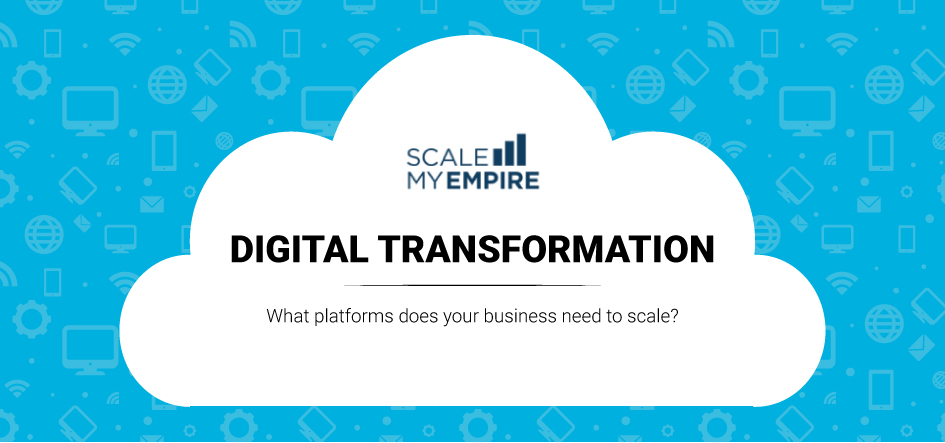
You’re seeing tons of revenue rolling in as your business scales up and that’s great news. But, how are you doing when it comes to maintaining margins?
Your business has blossomed over the past year. You’re thrilled to see such a substantial growth in sales and revenue.
But, that beautifully high margin you had as a small business is shrinking before your eyes.
Now is the perfect time to take a look at your business’s most important metric: your profit margin.
A Quick Review of Margin
Most entrepreneurs’ eyes light up at the word revenue.
But, Business Advisor Tony Collins of Aileron states that if you’re focusing too much on the revenue, then you’re only perpetuating “average results.”
You need to focus on more than just your revenue. The reality is that it doesn’t all go straight to your wallet anyway.
Gross profit is your revenue minus the cost of making sales.
Profit margin is what you have left over after deducting your business expenses from your gross profit.
What you’re left with after business costs is technically called ‘net margin’ (EBIT for the accounting folks).
After the government taxes (NPAT) are taken out of the remainder, you have your margin.
This margin is your key to scaling your company successfully.
Why Maintaining Margins Is So Important
There are plenty of business owners with the sole purpose of chasing revenue.
Admittedly, making sales both looks and feels good. Everyone’s giving high-fives on a great sale.
But, sales and revenue could be a hidden trap if you aren’t producing a healthy margin.
There are many elements already working to weaken your profits, overall. Things like changing customer demand and industry techniques can render your business obsolete almost overnight.
Fighting to maintain your margin is your best defense in a tough commercial world.
A margin represents your reward for running a successful business. If you do the math and plan things carefully, you’ll see a steady and welcome stream of cash coming in.
And, one of the important keys to successfully scaling your business is to invest back into it. You can’t do that if you’re short on funds due to a weak margin.
You sometimes have to spend some money if you want to earn more money. For a time, your business margin will represent the funds that you can afford to put right back into your company to promote growth and improved efficiency.
Maintaining margins in a healthy way also provides you with funds to thank your shareholders for their support and to reward yourself for your hard work.
You will also have more cash to direct into endeavors that are in line with your values, such as community projects.
Put simply, running a business while ignoring your margin is pointless. You could invest so much in terms of time and energy and wind up having nothing to show for it if you neglect your margin.
No one who starts a business does so with the intent of running themselves or their business into the ground! In branching out and building something of your own, you’re probably sharing with the world a passion of yours that you believe will serve others in a valuable way.
You likely started this company to secure your financial future or to follow your dreams and passions.
No matter what your reason is for starting a business, a company with a weak margin isn’t going to last long. Numbers and metrics may not be your forte but they are the difference between your business failing and watching your dreams and plans bloom.
Do yourself and your company a favor and grow that margin.
Let’s get into this because increasing your company’s profit margin may not come easily.
Did you know that maintaining margins is more important than simply making a profit? Learn here. Click To Tweet
Challenges to Improving Your Margin
Why do so many small businesses have a hard time growing their margins?
Here are a few of the most common obstacles growing businesses face when it comes to maintaining and growing their margins.
Challenge Number 1: Fast growth and poor decisions.
Rapid growth while your business was still in its early stages may have prompted you to make some hasty spending decisions which you now regret (that awesome shabby chic staff table for $5,000 wasn’t your best choice of investment).
Even though those decisions may have been few, they may have impacted some key elements of your business and led to lasting negative effects on your margin.
If you’re a small business struggling to make a profit, learn more about maintaining margins. Click To Tweet
Challenge Number 2: Hiring more staff.
While you were still just a small team, you didn’t need many employees. But, the recent growth necessitates taking on more people to fill the demands in production.
Not only do you need more people power to keep up with sales growth, but a growing team requires new roles in your company such as assistants, managers, HR, and finance staff.
Such positions aren’t always directly connected with generating revenue. They’re to ensure employee safety, rights, and satisfaction as well as maintain efficient organization.
So while not direct money-makers, these roles are essential to having a smoothly-functioning company. You can’t afford to not have them.
Still, more paychecks to fill often means having a smaller margin.

Here’s a generic team image that every services company website has. What are they talking about?
Challenge Number 3: Increasing costs.
Everything was so straightforward and simple when your business was new.
As your business continues to expand, however, you’ll have more IT support costs to maintain new business systems that you’ve implemented in the hopes of improving productivity.
Increased sales can also mean more spending in areas like marketing. The more you sell, the more you need to advertise. You can quickly get sucked into the vortex of marketing as you investigate increasingly more expensive marketing researchers.
And, you’re probably still reeling in confusion and frustration over where all of your money has been going these days! It’s just not as simple as it used to be.
Challenge Number 4: Inefficiency.
More isn’t always better when it comes to growing your business.
In the battle for maintaining margins, inefficiency is a silent killer.
Your business has become more complex with more staff and more resources for manufacturing your product or providing your service. The flurry of sudden activity during a growth boom can blind you to the subtle way inefficiency feeds off your margin like a parasite.
If your staff and resources aren’t efficient enough, you could be wasting money. You may wind up tripping over yourself, scrambling to afford paychecks for your growing staff and maintaining redundant process whilst generating less and less revenue.
This chips away at your margin.
Essentially, you could be doing less with more.
You may also enjoy: The Challenges of Growing a Business and How to Meet Them
How to Improve Your Margin
Let’s now talk about how you can boost your margin despite facing some of the challenges we’ve just discussed.
Systemisation and smart tech use are the keys to improving profitability so you’ll see these points pop up throughout the following tips.
Watch your cost of sale.
How much does it cost you to make a sale to a new client?
Find out this way. Have your sales team log how many hours they spend making sales in a given month. Multiply that by their hourly pay rates and then add on any other direct expenses, such as ads spent in marketing.
Divide that figure by the number of jobs/product you sold to a new client. That’s your simple average cost of sales.
Now it’s time to look for shortcuts. You want to make it cheaper to sell your product or service without lowering the price (which would contribute to a shrinking margin).
For example, you may realize that a lot of the time that goes into making a sale is spent by one salesperson traveling on the road to meet with clients or make a proposal.
Issues like these are easy to solve as we talk about here (link to blog on topic).
Another aspect to consider is your delivery system. You want that to be as fast and efficient as possible to save on expenses.
Basically, you want to make sure you know how much it will cost you to make a sale before going through with it. Don’t let yourself get so desperate to make a sale that you end up spending more than you’ll actually earn.

Spring clean your processes and procedures.
It’s easy to think that if the system you’ve been using for years is still working that there’s no need to make changes.
But, you’re bound to be up against some obstacles if you continue to believe that.
Scaling up means adapting your company’s process and procedures to ever-changing needs.
Scaling means a good spring cleaning for your standard operating procedures (SOPs).
Perhaps you’re facing a whole new client type. This would mean reimagining the customer experience. Think about what value you can deliver to your new customers and how. Don’t be afraid to start anew.
Your billing and supplier payment process may also need an overhaul.
Go ahead and compare other energy or Internet providers with the ones you currently have. You may find a better deal from another supplier for the materials for your company. Don’t be shy about shopping around or even asking for reduced rates. Anything you can do to save a few bucks!
Replace inefficient processes with new strategies. Do your research and stay open to new suggestions. Look into more ways of applying new technologies to your company with the aim of automating as many processes as possible.
This brings us to our next point.
Make the most of technology.
There’s no doubt that embracing technology is essential in remaining current and relevant in your industry.
Technology can even directly impact your margin. You need to carefully consider which processes will impact you in a positive way before you decide which ones to incorporate into your company.
Tech has a way of making processes cheaper and more efficient while still retaining and even enhancing value.
Take low-cost video conferencing, for example.
You could save hours by cutting out all of those little “coffee stops” with clients by simply communicating via video conference call.
What used to take an hour or more of your day just took five minutes.
Boom. That’s technology saving you time, saving you money.
If your sales process isn’t already taking advantage of technology like video chat, then now is a great time to think about it. Check out the ZOOM platform as an example of a video conferencing service that can help grow your profit margin.
Powerful project management tools such as Mavenlink can produce instant project margin reports and even initiate client billing from both your fixed price retainers and time and materials work.
These are just a couple of examples of technologies which can shave hours off of your standard procedures every single week. This will allow you to sell more work and deliver more services with a leaner team that operates on leaner procedures.
Smart tech application is a great way to cut out your company’s cash-drainers and amplify its money-making features.
Get a report.
Another key to improving your margin is knowing the true profitability of your services in the first place.
You can’t grow your margin until you know where it currently stands.

This is the point at which you get to decide where you want to see your business go. You’re putting the reins back into your own hands. You can make important decisions that will help your margin grow if you step back to examine the big picture.
Take the time to compare revenue and expenses. Analyze small things as well as the major ones.
Identify which areas are generating the most income and which are black holes for your hard-earned cash.
Once you’ve got all the figures on the table, you’ll be set to start rearranging your priorities.
To see where your team is both overspending and underspending their time, you need to break down a report. The report should show you your margins by comparing project expenses with the revenue earned. This will help you better determine what you should bill for on the next job.
You might be surprised to learn that the high revenue generating jobs are actually costing you the most money!
Restructure your team.
Outsourcing labor can be a controversial topic for some businesses.
But, successfully implementing this step at SME has improved our profitability across the board so we can recommend it with confidence.
In the ‘Network Economy’ also known as the ‘Gig Economy,’ the world is a much more connected and accessible place. Here, anyone can apply their trade, skills, experience, and knowledge to a business problem, anywhere in the world, at any time.
If you depend on contractors to deliver your customer experience, then you will need a more tightly-controlled sales and project delivery system. But this method is also more directly tied to your generating revenue.
This is because it’s easier to forecast your cashflow and manage your overheads when you can better predict the cost of labor.
As a result, your business will start to function like that fluid mathematical equation we all envy in internet marketers.
Stand out from the competition.
Wondering why you aren’t as successful as the bigger companies you strive to emulate?
“Stop looking at your competitors. Don’t match everything they do. Don’t make every move [they make],” says Tony Collins. “It’s really critical to not look like them.”
If all you do is copy the big guys, you won’t actually make any more than they do, relatively speaking.
Fine tune your company’s focus. Hone in on a particular niche or a unique need, something the general suppliers won’t be able to address.
“Specialists make more than generalists,” Tony emphasizes.
Think of how to solve problems in a way your larger rivals can’t.
Knowing your market and the demands and needs of your industry can help you make smart decisions for your company in terms of technology and staffing. The right decisions will boost your margin, the actual goal all businesses should strive for.
Your expense to income ratio (i.e. your profit margin) could wind up being much wider than those of your bigger competitors.
You don’t have to run with the big dogs to win the biggest bone.
So focus on how you can successfully build that margin rather than on just making sales to grow a truly successful empire.
Watch the rest of Tony’s insights here.
Get professional and experienced advice.
Scale My Empire shares the secrets to a truly successful company: maintaining margins Click To Tweet
At Scale My Empire, we’ve taken on all of the challenges when it comes to growing margins. We live the advice we share and that’s why we are qualified to help other businesses reach the same goals.




